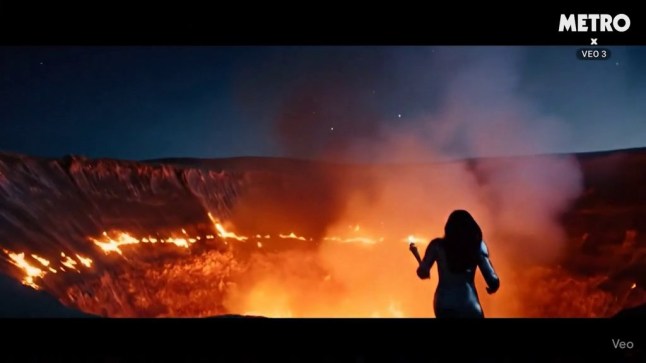We tried Google's new AI video to see if it's as mindblowing as it seems
2025-07-01 IDOPRESS

A scene from a big budget action film? No… Just something I made typing in a five-second prompt (Picture: Google Veo)
You’ve probably seen the highly realistic AI video saturating social media.
That Stormtrooper building a snowman? Made by Google Veo 3. The surfing unicorn passing ice floes while penguins rave under the northern lights? Also AI… we assume.
If you can dream it,you can create it,which is incredibly exciting – but also incredibly unsettling,in terms of what it means for creative industries as well as misinformation and fact checking.
A quick rundown: Google now allows you to create a cinematic video clip,just from typing in what you want to see. It includes realistic voices and sound,which sets it apart from other models.
Given I’ve never had skill as a filmmaker,I was amazed to be able to make a clip of something you’d previously need Hollywood special effects teams to conjure up,just from writing a couple of sentences on my computer.
The video below shows the three videos we made at Metro to test out the new tech,which Google launched in the UK on May 30.
For now,one of the annoying parts of making a video is that you can’t edit it; I can’t ask it to refine the clip and ask for the animal-loving editor not to drop his dog,for example. It would just come up with a new clip entirely.
Mr Lorrain said: ‘Adding the ability to more easily refine and finesse a prompt or generated video is definitely something we’re working on. For now,it’s a case of experimenting with the wording to try and get the video to generate as you’d like,which is trial and error,but it’s also part of the fun!’
Google is currently testing the ability to generate video from an image,which is one of the most in-demand as well as potentially concerning possibilities of AI video.
If you could upload an image of a real person,you could make a convincing deepfake with the potential to spread misinformation. But there are also legitimate reasons you might want to do this.
Reddit founder Alexis Ohanian recently shared a tweet of a video generated from a photo of his mother hugging him,using another AI software Midjourney. Explaining he lost his mother 20 years ago and that the family could not afford a camcorder,he had no moving images to remember her by so created the short animation to better imagine what happened either side of the shot.
Damn,I wasn't ready for how this would feel. We didn't have a camcorder,so there's no video of me with my mom. I dropped one of my favorite photos of us in midjourney as 'starting frame for an AI video' and wow… This is how she hugged me. I've rewatched it 50 times. pic.twitter.com/n2jNwdCkxF
— Alexis Ohanian 🗽 (@alexisohanian) June 22,2025
People might also understandably want to imagine themselves in James Bond-like situations,or more boringly,for more polished content on their socials.
For now,you also cannot specify a famous person in the written prompt and make a video of them using publicly available images,even though this would technically be possible (there are both legal and ethical reasons for this).
I asked Gemini for a video of Keir Starmer giving a speech outside Downing Street to warn of an invasion of glowing,radioactive hamsters just to see,but sadly was blocked from bringing this into technicolour.
How can I make a video with Google Veo 3?
It is currently only available to those with a subscription,which costs £18.99 a month.
Once you have access,you can simply type your prompt into Gemini,the company’s rival to ChatGPT,or use Flow,which is designed for more serious AI filmmaking,and allows the use of consistent elements such as a particular character across clips.
Users can make three clips a day,to prevent servers being overloaded.
To make the film,you simply write a paragraph about what you want it to show,detailing the style and camera work as well as the subject and script. Google gave a list of tips for a successful prompt here.
What’s up with the sound?
Google warns users on Flow that audio is still an experimental feature and so videos ‘might not always have sound’ (so if this happens to you,it’s not a problem with your speakers).
They said speech does better with slightly longer transcripts,is muted for minors,and can trigger subtitles.
‘We’re working on it,’ they said.
Will I be seeing this in cinemas soon?
It’s a safe bet that AI will be shaking up filmmaking,just as it is every other industry.
You can already generate a realistic-sounding ‘podcast’ on any topic just from uploading information about it,and I wouldn’t be surprised if you could generate your own feature films soonish on any topic you like too,without having to log into Disney Plus or Netflix at all. Admittedly,the quality would probably be mixed,and there could be copyright issues if you just uploaded a manuscript of the latest bestseller.
Mr Lorrain said: ‘With regards to the future,as with any groundbreaking technology,we’re still understanding the full potential of AI in filmmaking. We see the emergence of these tools as an enabler,helping a new wave of filmmakers more easily tell their stories. By offering filmmakers early access to Flow,we were able to better understand how our technology could best support and integrate into their creative workflows — and we’ve woven their insights into Flow.
‘Veo 3 represents a huge step forward in quality,with greater realism,4K output,and incredibly lifelike physics and audio. Like any powerful creative tool,it rewards practice—the more descriptive your prompts,the better your video. When it comes to getting the most out of Veo 3,think of prompting as learning to speak Veo’s language—the more fluently and descriptively you articulate your vision,the better the video will be.’

